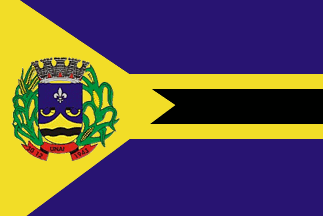 image by
Dirk Schönberger, 27 September 2010
image by
Dirk Schönberger, 27 September 2010Source: adapted from http://www.prefeituraunai.mg.gov.br/simbolos_municipais/index.php?page=bandeira.htm

Last modified: 2011-02-05 by ian macdonald
Keywords: minas gerais | unaí |
Links: FOTW homepage |
search |
disclaimer and copyright |
write us |
mirrors
 image by
Dirk Schönberger, 27 September 2010
image by
Dirk Schönberger, 27 September 2010
Source: adapted from
http://www.prefeituraunai.mg.gov.br/simbolos_municipais/index.php?page=bandeira.htm
A dark blue flag, with a central horizontal black stripe, fimbriated yellow, and yellow triangle extending off the hoist bearing the municipal arms.
Official website at
http://www.prefeituraunai.mg.gov.br/
Dirk Schönberger, 27 September 2010
The municipality of Unaí (78,125 inhabitants in 2009; 8,464 sq. km) is
located in north-western Minas Gerais. By Provincial Law No. 1,993, adopted
in 1873, the village of Rio Preto (Black River) was made a district of the
municipality of Paracatu, which was confirmed by State Law No. 2, adopted on
14 September 1891. Law No. 843, adopted on 7 September 1923, changed the name
of the district to Unaí, meaning Black River in native language. The
municipality of Unaí was formed by State Law No. 1,058, adopted on 31
December 1943, merging the districts of Unaí, Fróis and Garapuava (formerly
part of Paracatu) and Buritis and Serra Bonita (formerly part
of São Romão).
http://www.prefeituraunai.mg.gov.br/nossahistoria/index.php?page=nossa_historia.htm - Municipal website
The symbols of Unaí are prescribed by
Municipal Law No. 931/810, adopted on 20 August 1980. The full text of the
law is available on the municipal website. I give below only the articles
describing and explaining the symbols, skipping the articles prescribing the
symbols' use.
Chapter I. Preliminary provisions.
Article 1. The
municipal symbols of Unaí (MG) shall be, as provisioned by § 3 of Article 1
of the Federal Constitution:
a) the municipal coat of arms
b) the
municipal flag
c) the municipal anthem.
Chapter II. Design of the
municipal symbols.
[...]
Section II. Municipal flag.
Article 6. The
municipal flag of Unaí, designed by the heraldist and vexillologist Pr.
Arcinóe Antonio Peixoto de Faria, shall be tierced per fess, the outer, blue
fesses being of five modules in height and the central, yellow fess being of
four modules in width and charged with a black fess, from which emerges a
yellow isosceles triangle charged with the municipal coat of arms.
§1. As
prescribed by the canons and rules of municipal heraldry inherited from
Portugal, the municipal flags can be gyroned in eight or six parts, quartered
or tierced, with the municipal coat of arms placed in the middle or at hoist.
The colour shall be those of the arms, arranged harmoniously.
§2.
Occasionally, the vexillologist designing the flag can use other arrangements
of the colours, but respecting the meaning of the arms. [...]
Section IV. Municipal arms.
Article 19. The arms of Unaí, designed by the
heraldist and vexillologist Pr. Arcinóe Antonio Peixoto de Faria, is described
as follows: Classic, Flemish-Iberian shield surmounted by an eight-towered
mural crown port and windows gules, azure in chief a fleur-de-lis argent two
cowboy's hunting horns stylized or, a mantle or a fess wavy sable. The shield
surrounded dexter by a rice plant and sinister by a maize plant proper
crossed per saltire and supporting a scroll gules charged with the toponym "Unaí"
and the date "30.12.1943" in Argentine letters.[...]
Article
22. [...] The symbolic meaning of the arms is the following:
a) The Classic,
Flemish-Iberian shield, of German origin, was used in all the Iberian Peninsula
and especially in Portugal. This style was preferred, even if history tells
that the first style introduced in Portugal was the Samnite style, of French
origin and introduced into Portugal by French-born Count Henry of Burgundy,
the founder of the Country of Portugal.
b) The mural crown, the universal
symbol used on municipal arms, made of eight towers, of which five are
visible, recalls that the represented town is of second rank; the red
openings recalls that the town is the seat of a "comarca".
c) The blue
color is a symbol of justice, nobleness, perseverance, zeal, loyalty,
recreation and beauty.
d) The fleur-de-lis argent (silver), the symbol of the
Blessed Virgin, recalls that the patron saint of the down is Our Lady of
Conception.
e) The yellow cowboys' hunting horns represent one of the source
of income of the municipality.
f) The yellow color (gold) is the heraldic
symbol of wealth, nobleness, perseverance, glory and splendor.
g) The fess
wavy sable (black) recalls that Unaí means "Black River".
h) The supporters -
rice and maize - represent two main crops of the municipality.
i) Finally,
the ribbon gules (red) symbolizes bravery, intrepidity, courage and valiance,
on which is written in silver-gilded Argentine letters the toponym "Unaí" and
the date of the political emancipation of the town, 30.12.1943.
[...]
http://www.prefeituraunai.mg.gov.br/simbolos_municipais/index.php?page=bandeira.htm
An official anthem to the municipal flag - different from
the municipal anthem - was composed by Lucimar de Jesus Alves da Rocha
(aka Lúcio Rocha), with arrangements by João Pereira Filho and Elias de Jesus
Pires.
http://www.prefeituraunai.mg.gov.br/simbolos_municipais/index.php?page=hino_a_bandeira_de_unai.htm
Ivan Sache, 1 October 2010